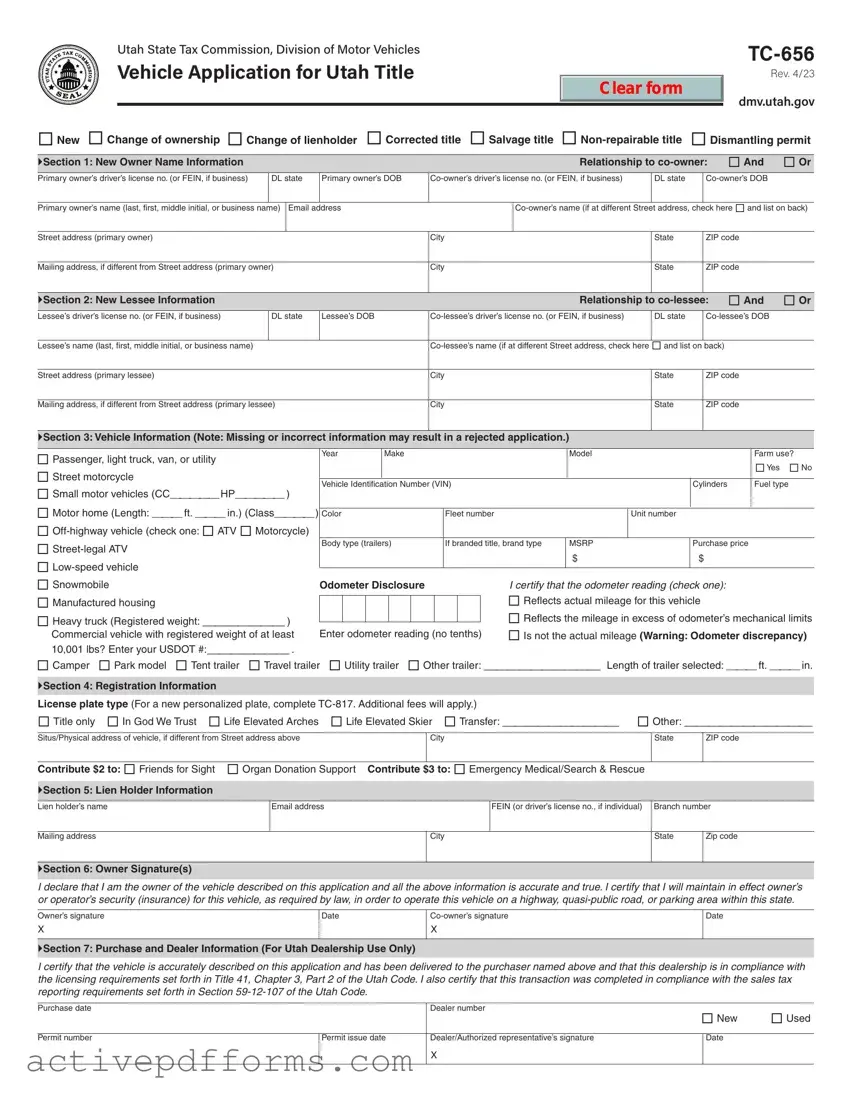- What is the Utah DMV TC 656 form used for?
The Utah DMV TC 656 form is a versatile document used for several key vehicle-related purposes. These include applying for a new title, changing ownership of a vehicle, updating lienholder information, correcting details on an existing title, and acquiring salvage, non-repairable, or dismantling titles. It’s essential for individuals or businesses involved in buying, selling, or altering vehicle ownership details in Utah.
- How do I fill out the "New Owner Name Information" section?
When completing the "New Owner Name Information" section, you'll need to provide detailed information about the primary and co-owner (if applicable), including their full names, driver’s license numbers (or FEIN for businesses), states where the licenses were issued, dates of birth, and contact information. It's crucial to decide and indicate the relationship between co-owners using the "And" or "Or" checkbox, which determines how the ownership is shared or divided.
- What is required in the "Vehicle Information" section?
In the "Vehicle Information" section, accurate details about the vehicle must be recorded, such as the type of vehicle, year, make, model, Vehicle Identification Number (VIN), and other specifics like cylinders, fuel type, body type, and odometer disclosure. Filling this section accurately is vital to avoid application rejection due to missing or incorrect information.
- Can I specify a different address for the vehicle?
Yes, if the situs/physical address of the vehicle differs from the street address provided in earlier sections, you can specify this in the "Registration Information" section. This is particularly useful if the vehicle is kept at a different location than the owner's mailing address.
- What should I do if my vehicle is for farm use?
If your vehicle is used for farm purposes, you should indicate this by checking the "Yes" box next to "Farm use?" in the "Vehicle Information" section. This classification can affect the vehicle’s registration process and requirements.
- How do I handle the odometer disclosure on the form?
The odometer disclosure section requires you to attest to the accuracy of the vehicle's mileage by checking one of the options that best describes the odometer reading. You must enter the current odometer reading without tenths and select whether it reflects the actual mileage, exceeds the mechanical limits, or if the mileage isn’t accurate due to a discrepancy.
- What information is needed for the "Lien Holder Information" section?
When filling out the "Lien Holder Information" section, provide the lien holder’s name, mailing address, email address, FEIN (or driver’s license number if it is an individual), and the branch number if applicable. This section is crucial for registering a lien against the vehicle.
- How do I indicate my desire to contribute to charity through my registration?
In the "Registration Information" section, you have the option to contribute to specific charities, including "Friends for Sight" and "Organ Donation Support" by contributing $2, or to the "Emergency Medical/Search & Rescue" by contributing $3. Make sure to check the applicable box(es) to include this with your registration.
- Who needs to sign the TC 656 form?
The TC 656 form must be signed by the vehicle's primary owner and co-owner (if there is one) in the "Owner Signature(s)" section. By signing, each party declares that the information provided is accurate and true, and certifies that insurance requirements, as mandated by law, will be maintained for the vehicle.
- Is this form only for use by Utah residents?
While the TC 656 form is specifically designed for vehicle transactions in Utah, it might also be required for out-of-state residents who are buying a vehicle in Utah or transferring a vehicle title to Utah. It’s designed to comply with the legal requirements set forth by Utah law for vehicle registration and title changes.

